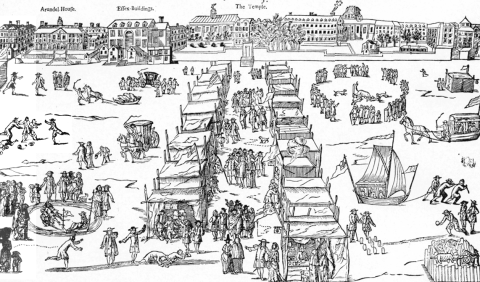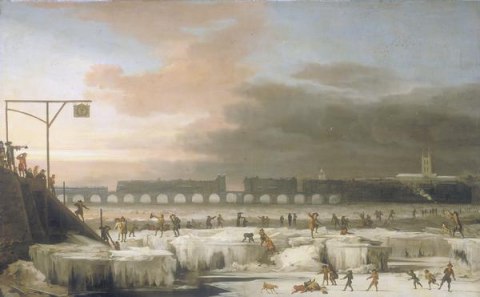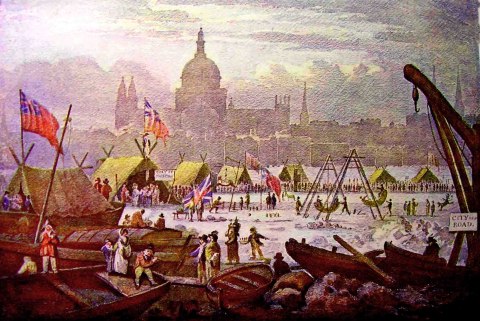Iris
Justified & Ancient
- Joined
- May 22, 2004
- Messages
- 2,984
Reminded me of this.
Although these harsh winters often brought with them famine and death, it was the local Londonders – as enterprising and resilient as ever – who decided to make the most of it and set up the Thames Frost Fairs. In fact, between 1607 and 1814 there were a total of seven major fairs, as well as countless smaller ones.
These Frost Fairs would have been quite a spectacle, full of hastily constructed shops, pubs, ice skating rinks… everything that you would expect in the crowded streets of London but on ice!
The first recorded frost fair was during the winter of 1607 / 08. During December the ice had been firm enough to allow people to walk between Southwark to the City, but it was not until January when the ice became so thick that people started setting up camp on it. There were football pitches, bowling matches, fruit-sellers, shoemakers, barbers… even a pub or two. To keep the shopkeepers warm, there were even fires within their tents!

The Frost Fair in 1683 / 84
During the Great Winter of 1683 / 84, where even the seas of southern Britain were frozen solid for up to two miles from shore, the most famous frost fair was held: The Blanket Fair. The famous English writer and diariest John Evelyn described it in extensive detail, writing:
Coaches plied from Westminster to the Temple, and from several other staires to and fro, as in the streetes, sliding with skeetes, a bull-baiting, horse and coach races, puppet plays and interludes, cookes, tipling and other lewd places, so that it seemed a bacchanalian triumph or carnival on the water, whilst it was a severe judgement on the land, the trees not onely splitting as if lightning-struck, but men and cattle perishing in divers[e] places, and the very seas so lock’d up with ice, that no vessels could stir out or come in.
Even kings and queens would join in the festivities, with King Charles reportedly enjoying a spitroasted ox at this very fair.

In this painting from 1677, you can see how thick the ice would have been on the Thames.
However, as you may imagine from holding a festival on a rather precarious piece of ice, there was the occasional tragedy. During the fair of 1739 a whole swathe of ice gave away and swallowed up tents and businesses as well as people.
Another tragedy occurred at the fair in 1789 where melting ice dragged away a ship which was anchored to a riverside pub in Rotherhithe. As the ‘Gentleman’s Magazine’ wrote at the time:
“The captain of a vessel lying off Rotherhithe, the better to secure the ship’s cables, made an agreement with a publican for fastening a cable to his premises. In consequence, a small anchor was carried on shore, and deposited in the cellar, while another cable was fastened round a beam in another part of the house. In the night the ship veered about, and the cables holding fast, carried away the beam, and levelled the house with the ground, by which accident five persons asleep in their beds were killed.”

The last ever Frost Fair held in 1814 / 15
By the 1800’s the climate had started to warm, the severity of the winters had waned and the last ever London Frost Fair took place in the January of 1814. Although only lasting for five days, this was to be one of the largest fairs on record. Thousands of people turned up every day, and there was said to be every possible form of entertainment including a parading elephant!
“At every glance, there was a novelty of some kind or other. Gaming was carried on in all its branches. Many of the itinerant admirers of the profits gained by E O Tables, Rouge et Noir, Te-totum, wheel of fortune, the garter, were industrious in their avocations, and some of their customers left the lures without a penny to pay the passage over a plank to the shore. Skittles was played by several parties, and the drinking tents were filled by females and their companions, dancing reels to the sound of fiddles, while others sat round large fires, drinking rum, grog, and other spirits. Tea, coffee, aud eatables, were provided in abundance, and passengers were invited to eat by way of recording their visit. Several tradesmen, who at other times were deemed respectable, attended with their wares, and sold books, toys, and trinkets of almost every description.”
Perhaps the river would have frozen over a few more times before the end of the Little Ice Age, but the demolishing of the medieval London Bridge in 1831 meant that this was not to be. Instead, the fair of 1814 would be the last.
The Thames Frost Fairs
Between 1600 and 1814, it was not uncommon for the River Thames to freeze over for up to two months at time. There were two main reasons for this; the first was that Britain (and the entire of the Northern Hemisphere) was locked in what is now known as the ‘Little Ice Age’. The other catalyst was the medieval London Bridge and its piers, and specifically how closely spaced together they were. During winter, pieces of ice would get lodged between the piers and effectively dam up the river, meaning it was easier for it to freeze.Although these harsh winters often brought with them famine and death, it was the local Londonders – as enterprising and resilient as ever – who decided to make the most of it and set up the Thames Frost Fairs. In fact, between 1607 and 1814 there were a total of seven major fairs, as well as countless smaller ones.
These Frost Fairs would have been quite a spectacle, full of hastily constructed shops, pubs, ice skating rinks… everything that you would expect in the crowded streets of London but on ice!
The first recorded frost fair was during the winter of 1607 / 08. During December the ice had been firm enough to allow people to walk between Southwark to the City, but it was not until January when the ice became so thick that people started setting up camp on it. There were football pitches, bowling matches, fruit-sellers, shoemakers, barbers… even a pub or two. To keep the shopkeepers warm, there were even fires within their tents!

The Frost Fair in 1683 / 84
During the Great Winter of 1683 / 84, where even the seas of southern Britain were frozen solid for up to two miles from shore, the most famous frost fair was held: The Blanket Fair. The famous English writer and diariest John Evelyn described it in extensive detail, writing:
Coaches plied from Westminster to the Temple, and from several other staires to and fro, as in the streetes, sliding with skeetes, a bull-baiting, horse and coach races, puppet plays and interludes, cookes, tipling and other lewd places, so that it seemed a bacchanalian triumph or carnival on the water, whilst it was a severe judgement on the land, the trees not onely splitting as if lightning-struck, but men and cattle perishing in divers[e] places, and the very seas so lock’d up with ice, that no vessels could stir out or come in.
Even kings and queens would join in the festivities, with King Charles reportedly enjoying a spitroasted ox at this very fair.

In this painting from 1677, you can see how thick the ice would have been on the Thames.
However, as you may imagine from holding a festival on a rather precarious piece of ice, there was the occasional tragedy. During the fair of 1739 a whole swathe of ice gave away and swallowed up tents and businesses as well as people.
Another tragedy occurred at the fair in 1789 where melting ice dragged away a ship which was anchored to a riverside pub in Rotherhithe. As the ‘Gentleman’s Magazine’ wrote at the time:
“The captain of a vessel lying off Rotherhithe, the better to secure the ship’s cables, made an agreement with a publican for fastening a cable to his premises. In consequence, a small anchor was carried on shore, and deposited in the cellar, while another cable was fastened round a beam in another part of the house. In the night the ship veered about, and the cables holding fast, carried away the beam, and levelled the house with the ground, by which accident five persons asleep in their beds were killed.”

The last ever Frost Fair held in 1814 / 15
By the 1800’s the climate had started to warm, the severity of the winters had waned and the last ever London Frost Fair took place in the January of 1814. Although only lasting for five days, this was to be one of the largest fairs on record. Thousands of people turned up every day, and there was said to be every possible form of entertainment including a parading elephant!
“At every glance, there was a novelty of some kind or other. Gaming was carried on in all its branches. Many of the itinerant admirers of the profits gained by E O Tables, Rouge et Noir, Te-totum, wheel of fortune, the garter, were industrious in their avocations, and some of their customers left the lures without a penny to pay the passage over a plank to the shore. Skittles was played by several parties, and the drinking tents were filled by females and their companions, dancing reels to the sound of fiddles, while others sat round large fires, drinking rum, grog, and other spirits. Tea, coffee, aud eatables, were provided in abundance, and passengers were invited to eat by way of recording their visit. Several tradesmen, who at other times were deemed respectable, attended with their wares, and sold books, toys, and trinkets of almost every description.”
Perhaps the river would have frozen over a few more times before the end of the Little Ice Age, but the demolishing of the medieval London Bridge in 1831 meant that this was not to be. Instead, the fair of 1814 would be the last.





 ngw:
ngw:

